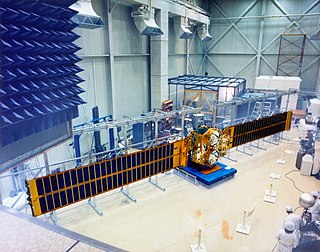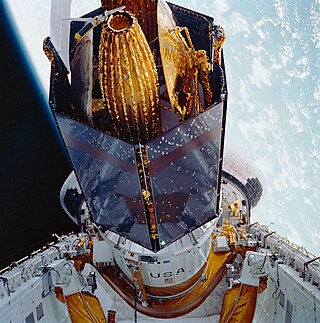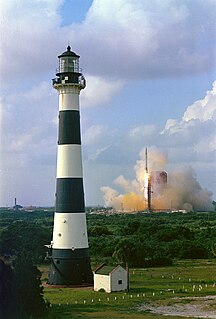Related Research Articles

The Communications Technology Satellite (CTS), known as Hermes, was an experimental high-power direct broadcast communications satellite. It was a joint effort of Canadian Department of Communications, who designed and built the satellite, NASA who tested, launched and operated the satellite, and European Space Agency (ESA) who provided the 1200 watts solar panels and other devices. The three agencies shared the satellite and the data from the experiments.

TDRS-3 , known before launch as TDRS-C, is an American communications satellite, of first generation, which is operated by NASA as part of the Tracking and Data Relay Satellite System. It was constructed by TRW, and is based on a custom satellite bus which was used for all seven first generation TDRS satellites.
Kosmos 165, also known as DS-P1-Yu No.11 was a radar calibration target satellite which was used by the Soviet Union for tests of anti-ballistic missiles. It was a 400 kilograms (880 lb) spacecraft, which was built by the Yuzhnoye Design Office, and launched in 1967 as part of the Dnepropetrovsk Sputnik programme.

Kosmos 14, also known as Omega No.1, was a satellite which was launched by the Soviet Union in 1963. It was an Omega satellite, derived from the Dnepropetrovsk Sputnik series.
Intelsat II was a series of four communications satellites operated by Intelsat which were launched in 1966 and 1967. Built by the Hughes Aircraft Company, the Intelsat II series was a follow-up to the Intelsat I series, of which only one satellite was launched.
Intelsat III F-2 was a communications satellite operated by Intelsat. Launched in 1968 it was operated in geostationary orbit at a longitude of 24 degrees west for around eighteen months.
Intelsat III F-3 was a geostationary communications satellite operated by Intelsat. Launched in 1969 it was intended for operations over the Pacific Ocean; however, it spent most of its service life over the Indian Ocean at a longitude of 63 degrees east.
Intelsat III F-6 was a communications satellite owned by Intelsat. The satellite had an estimated useful life of 5 years.
Intelsat III F-8 was a communications satellite owned by Intelsat. The satellite had an estimated useful life of 5 years.
Intelsat IV F-4 was a geostationary communication satellite built by Hughes, it was owned by Intelsat. The satellite was based on the HS-312 platform and its estimated useful life was 7 years.

Intelsat IV F-5 was a geostationary communication satellite built by Hughes, it was owned by Intelsat. The satellite was based on the HS-312 platform and its estimated useful life was 7 years.
Intelsat V F-1 was a geostationary communications satellite built by Ford Aerospace, it was owned by COMSAT. Launched in 1981, it was the second of fifteen Intelsat V satellites to be launched. The satellite was based on the Intelsat V platform and its estimated useful life was seven years.
Intelsat V F-2, then named Intelsat 502, was a communications satellite operated by COMSAT. Launched in 1980, it was the first of fifteen Intelsat V satellites to be launched. The Intelsat V series was constructed by Ford Aerospace, based on the Intelsat V satellite bus. Intelsat V F-2 was part of an advanced series of satellites designed to provide greater telecommunications capacity for INTELSAT's global network.
Intelsat 510, previously named Intelsat VA F-10, was a communications satellite operated by Intelsat. Launched in 1985, it was the tenth of fifteen Intelsat V satellites to be launched. The Intelsat V series was constructed by Ford Aerospace, based on the Intelsat-VA satellite bus. Intelsat VA F-10 was part of an advanced series of satellites designed to provide greater telecommunications capacity for Intelsat's global network.
Intelsat VA F-12, then named Intelsat 512, was a communications satellite operated by Intelsat. Launched in September 1985, it was the twelfth of fifteen Intelsat V satellites to be launched. The Intelsat V series was constructed by Ford Aerospace, based on the Intelsat VA satellite bus. Intelsat VA F-12 was part of an advanced series of satellites designed to provide greater telecommunications capacity for Intelsat's global network.
Intelsat VA F-13 or Intelsat 513, then named 'NSS-513', was a communications satellite operated by Intelsat and which was later sold to New Satellite Skies. Launched in 1988, it was the thirteenth of fifteen Intelsat V satellites to be launched. The Intelsat V series was constructed by Ford Aerospace, based on the Intelsat VA satellite bus. Intelsat VA F-13 was part of an advanced series of satellites designed to provide greater telecommunications capacity for Intelsat's global network.
Intelsat VA F-14, was a communications satellite operated by Intelsat. Launched in 1986, it was the fourteenth of fifteen Intelsat V satellites to be launched. The Intelsat V series was constructed by Ford Aerospace, based on the Intelsat VA satellite bus. Intelsat VA F-14 was part of an advanced series of satellites designed to provide greater telecommunications capacity for Intelsat's global network.
Intelsat VA F-15 or Intelsat 515, then named Columbia 515, was a communications satellite operated by Intelsat and which was later sold to Columbia Communications Corporation. Launched in 1989, it was the fifteenth of fifteen Intelsat V satellites to be launched. The Intelsat V series was constructed by Ford Aerospace, based on the Intelsat VA satellite bus. Intelsat VA F-15 was part of an advanced series of satellites designed to provide greater telecommunications capacity for Intelsat's global network, from an orbital station at 60.0° East.
Intelsat 907 was a communications satellite operated by Intelsat.
Hellas Sat 2 is a communications satellite operated by Hellas Sat. On 29 June 2017, the Hellas Sat 3 satellite was launched to replace the Hellas Sat 2.
References
- 1 2 "Display: Intelsat 5A F-11 1985-055A". NASA. 14 May 2020. Retrieved 29 June 2020.

- ↑ "Intelsat-5A". Gunter's Space Page. Retrieved April 23, 2017.
- ↑ McDowell, Jonathan. "Launch Log". Jonathan's Space Page. Retrieved April 23, 2017.
- 1 2 "Intelsat 511". TSE. Retrieved 29 June 2020.
- ↑ "Display: Intelsat 5A F-15 1989-086A". NASA. 14 May 2020. Retrieved 29 June 2020.

| This spacecraft or satellite related article is a stub. You can help Wikipedia by expanding it. |